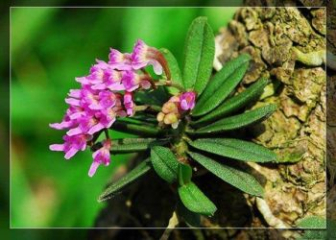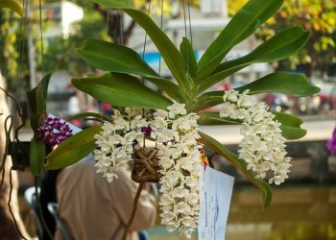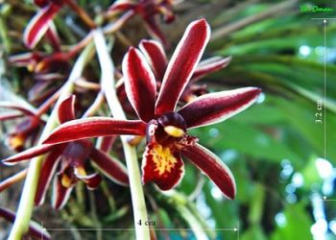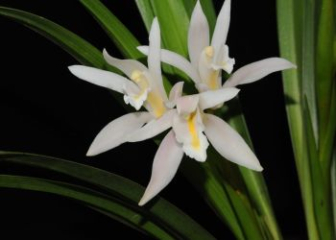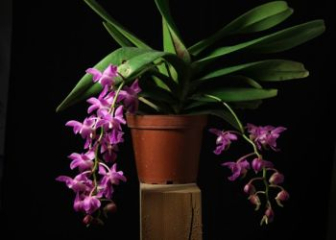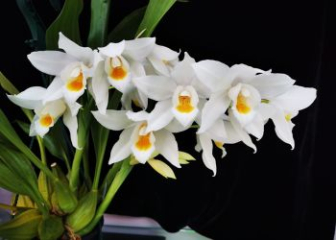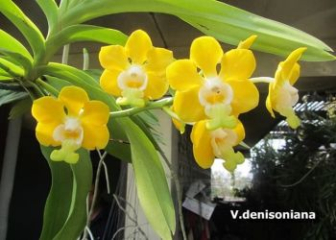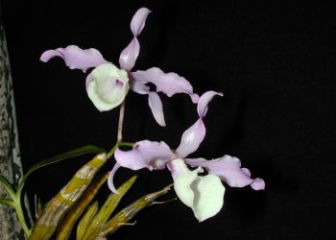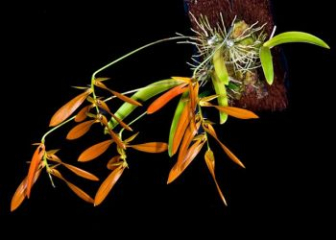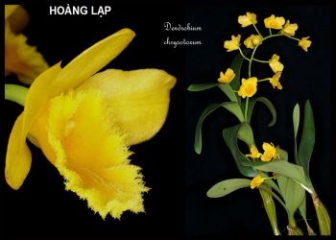Hairy Slipper Orchid - Origin, Characteristics and How to Grow from A to Z
Blog | by
Paphiopedilum hirsutissimum is a rare wild orchid species with large flowers of unique shape and impressive color, covered with hairs, and prefers a cool, humid climate.
Hairy Slipper Orchid is one of the rarest and most sought-after wild orchids today. It stands out with its wild and classic appearance thanks to its large, strangely shaped flowers covered with fine hairs.
In today's article, let's explore in detail the origin, characteristics, and how to grow and care for the Hairy Slipper orchid to better understand why this orchid is so highly appreciated by orchid collectors.
Origin of hairy orchid
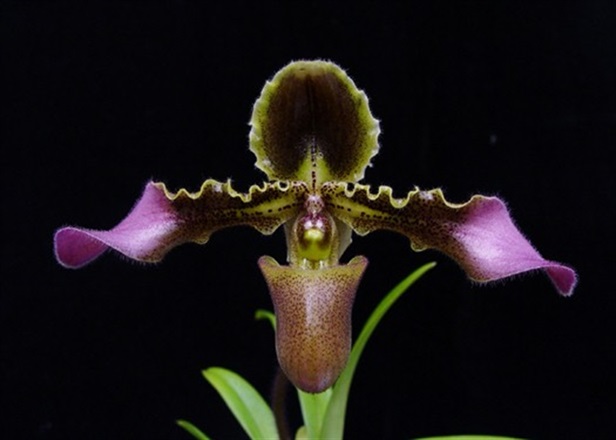
Hairy Paphiopedilum is a rare species of wild orchid.
Paphiopedilum hirsutissimum, also known as Paphiopedilum hirsutissimum, was first scientifically described in 1831 by a British botanist named John Lindley.
The hairy clam is native to tropical and subtropical Asia, widely distributed in some countries as follows:
- Vietnam: Lao Cai, Lai Chau, Son La, Nghe An
- China, Laos, Thailand, Myanmar,...
In nature, this orchid species often grows on the edges of rocky mountains, rocky crevices with humus or moist rotten vegetation in evergreen forests, low mountain rain forests, where there is high humidity and light scattering.
The name “Paphiopedilum hirsutissimum” is a combination of two words:
- Paphiopedilum: The Goddess's Door Shoe
- Hirsutissimum: Very hairy
⟹ Meaning a hairy clog - referring to the characteristic shape of the hairy slipper orchid.
Currently, due to over-exploitation, the number of hairy orchids in nature is seriously decreasing, even being classified in "Appendix I CITES" - "International Convention on the Prohibition of Trade in Endangered Species of Wild Fauna and Flora", strictly prohibiting export without a license.
Signs to identify hairy orchid
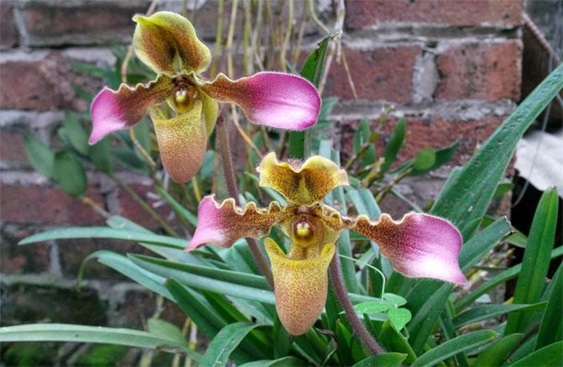
Hairy Slipper orchids look very special and unique.
The Hairy Paphiopedilum is one of the most impressive looking wild orchids with large, hairy flowers and a unique shape. Specifically as follows.
Body - root :
- No pseudobulb, short stem, grows close to the base
- Roots are clustered and develop strongly.
- The plant grows in clumps and spreads horizontally.
Leaves :
- The leaves are lanceolate, dark green, and slightly shiny.
- Leaves are 15 - 30 cm long and 3 - 5 cm wide.
- Leaves are thick, hard, growing symmetrically on both sides of the stem.
Flower :
- A hairy orchid plant produces only one flower on a single stem.
- Flower stalks are 15 - 30 cm long, covered with a layer of fine purple-brown hairs.
- Flowers are large in size from 7 - 12 cm, quite large compared to other orchid species.
- The flower lip is shaped like a clog, the two petals on the side of the ovary are thick, long, reddish brown/purple in color and covered with a layer of fine hairs.
- The flower at the top is triangular and rounded, with many hairs.
- Stamens are dome-shaped, lemon yellow or greenish white.
- Petals are purple-brown, red-brown or green-brown, with additional veins or stripes, the lip is yellow-brown, copper or light purple, sometimes moss green.
- Flowers have a light, gentle scent.
- Flowers usually bloom in late spring - early summer, from March to May, each flower blooms for 15 - 20 days.
How to grow and care for hairy orchids suitable for Vietnam's climate
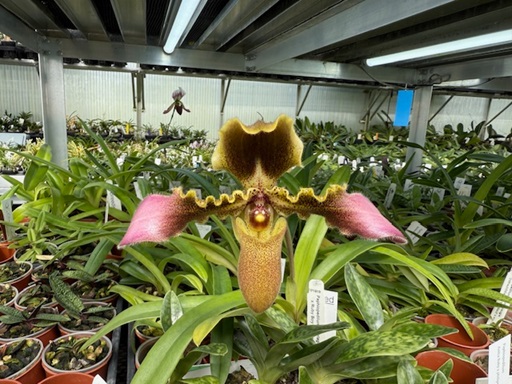
Detailed technical instructions for growing Hairy Slipper Orchids.
The Hairy Paphiopedilum is a species of orchid that likes to live in subtropical climates with high humidity, so it is suitable for planting in the North, Central or Central Highlands of our country. However, to ensure that they can grow best, please refer to the detailed planting & care instructions shared below.
Selecting and processing hairy orchid varieties
First, you need to pay attention to choosing and processing the breed to help your orchid pot grow in the best way.
Origin of breed :
- You should choose pure garden hairy orchid because it is easy to grow, has few pests and diseases and good adaptability.
- Limit the selection of orchids directly exploited from the forest because of low survival rate, difficult to domesticate, and easy to carry pathogens.
Criteria for selecting standard hairy orchid varieties :
- Choose plants with sturdy stems and no signs of pests or diseases.
- Dark green leaves, shiny, not crushed
- Prioritize plants with many white roots and young roots.
- Choose a tree with young shoots emerging as much as possible.
Treatment of hairy orchid varieties before planting :
- Cut off damaged, rotten roots and leaves, wash to remove moss and soil remaining at the base.
- Soak seedlings in diluted Physan 20 or Benkona solution for 10 - 15 minutes to kill fungus.
- Continue to soak the plant in root stimulant solution (if needed) such as Rootplex, Atonik, N3M for 20 - 30 minutes.
- Hang the seedlings in a cool place for 1-2 days to let the plants drain completely and avoid heat shock.
Select and process the growing medium for hairy orchids
One of the important factors that determine the survival of the hairy orchid is that you need to choose the right substrate and handle it properly.
Substrate requirements :
- Easy drainage
- No quick item
- Has the ability to retain moisture relatively
- Germ free
Suitable substrates :
- Pine bark
- Chilean coir, soft coir
- Moss
- Charcoal chips
- Pumice
Substrate treatment :
- Soak or boil growing media such as pine bark, coir, moss for about 10 - 15 minutes then dry for 1 - 2 days to disinfect.
- For charcoal and rocks, you can sprinkle lime powder or Benkona for light disinfection.
How to grow hairy orchid in pot
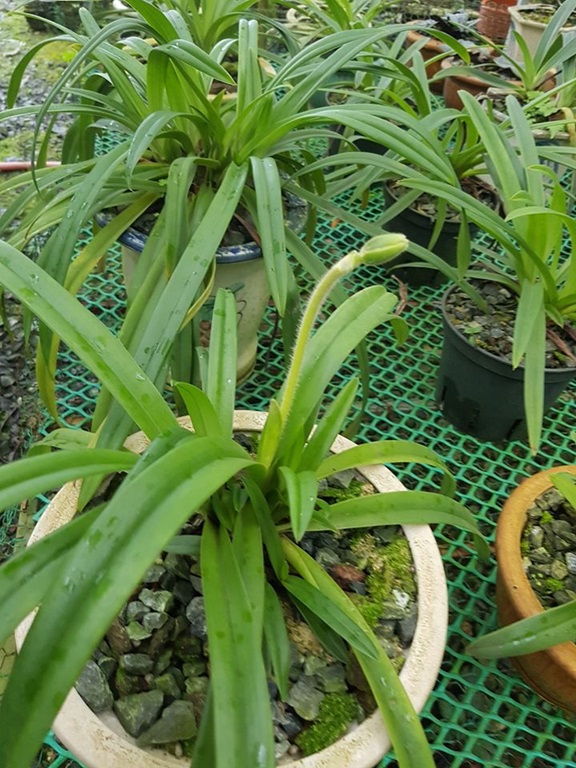
How to plant hairy orchid in pot in detail.
Hairy Paphiopedilum is best grown in pots instead of grafted onto substrate. And to help the orchid pot take root soon and grow well, please follow the instructions below.
- Step 1 : Spread a layer of light gravel, charcoal or pumice at the bottom of the pot, then spread a layer of large pine bark on top.
- Step 2 : Place the tree in the middle of the pot, align the roots so they spread out evenly and do not fold.
- Step 3 : Cover the base with a layer of growing medium such as small pine bark, soft coconut fiber, etc., and press gently to help your orchid stand firmly.
- Step 4 : Cover the substrate with a layer of moss to keep it moist.
- Step 5 : During the first 3-5 days, you should only lightly mist around the pot, place the pot in a cool place, and from the 5th day onwards, start lightly watering the orchid roots.
Hairy Paphiopedilum Orchid Care from A to Z
To ensure that the hairy orchid pot can grow healthily, has few pests and diseases, and blooms on time, please refer to the instructions for caring for this orchid species shared here. We guarantee that your conquest of this precious orchid species will be easier.
Pot placement :
- Place the plant in a well-ventilated, windy place.
- Cool, stable temperature from 15 - 28 degrees Celsius
- Scattered light from 50 - 70%
- It is best to place the pot under a black mesh, awning or under a natural tree canopy.
How to water :
- Basic principles: Watering at the right time - right amount - right way
- Spring - summer: Water 3 - 4 times/week, if the weather is too dry, you can spray a light mist at noon.
- Rainy season: Check the growing medium and only water when it feels too dry.
- Winter: Reduce watering, only water 1 - 2 times/week
Fertilization by stage:
|
Stage |
Fertilizer type |
Frequency |
|
Growth and development |
NPK 30-10-10, Humic, Atonik |
10 days/time |
|
Hairy Paphiopedilum is about to bloom. |
NPK 6-30-30, slow-release organic fertilizer |
10 - 15 days/time |
|
Post-flowering stage |
NPK 20-20-20, organic fertilizer helps plants recover |
10 days/time |
|
Maintain regularly all year round |
B1, organic fertilizer, multivitamins |
Fertilize alternately, once a month. |
Note: Apply only ⅓ - ¼ of the recommended dose compared to the instructions on the package.
Disease prevention for hairy slipper orchids
Like some other orchid species, Hairy Paphiopedilum can suffer from some common diseases such as root rot, stem rot or mealybugs, red spiders, fungi,... if not properly cared for. Here are some optimal disease prevention measures, you can refer to them.
- Basic principles "keep the substrate clean - not wet for long - airy environment"
- Observe the orchid pot every day to detect early signs of abnormalities.
- Do not water at night, do not let water accumulate at the base or leaves because it can easily cause root and leaf rot.
- Spray antifungal and antibacterial drugs periodically: Physan 20, Ridomil Gold, Chitosan
- Spray pesticides Confidor 100 SL, Neem oil, Radiant 60SC
Hairy Slipper Orchid Price List
Currently, the hairy slipper orchid is classified as one of the rare wild orchid species, so its price is relatively high compared to other popular orchid species. For details, please refer to the price list below.
|
Hairy Slipper Orchid |
Reference price (VND) |
|
Hairy slipper orchid (with 1 - 2 leaves) |
150,000 - 300,000 VND/tree |
|
Mature hairy slipper orchid, no flowers yet |
300,000 - 600,000 VND/tree |
|
Large bushy Paphiopedilum, with flower spike |
1,500,000 - 3,000,000 VND/pot |
|
Wild hairy orchid |
500,000 - 800,000 VND/tree |
Note: You need to note that the Hairy Slipper orchid is in CITES Appendix I, so when buying seedlings, you need to pay attention to the origin issue, only buy purebred and legally propagated plants to avoid legal risks.
Questions and answers about hairy orchids
Are hairy slipper orchids difficult to grow?
The hairy slipper orchid is not an easy orchid to grow, but you just need to maintain a cool, humid, airy environment and master some basic techniques that we share above to be able to confidently try your hand at this special slipper orchid.
What month does the hairy orchid bloom?
Normally, the hairy orchid blooms in March - May every year, depending on care conditions but it will not deviate too much.
Do hairy orchids like light?
No, the hairy orchid only likes 50 - 70% diffused light, equivalent to early morning sunlight or indirect sunlight, and cannot tolerate harsh light at noon.
Beautiful and impressive hairy orchid images
Please take a look at some of the images of the Hairy Orchid that we have collected below to fully appreciate the special shape and color of this rare wild orchid.
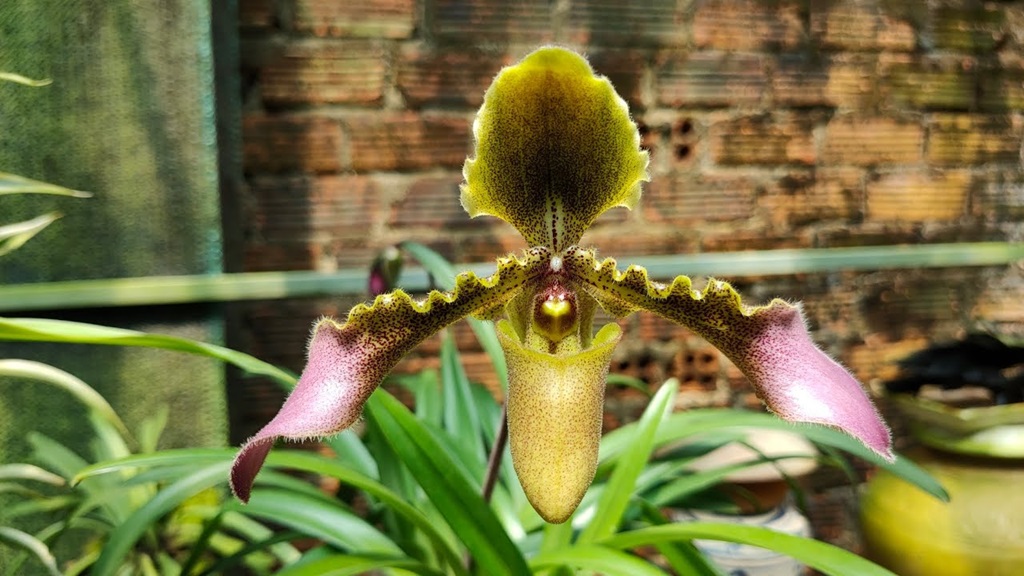
Close-up of the flower face of the super impressive Hairy Slipper orchid.
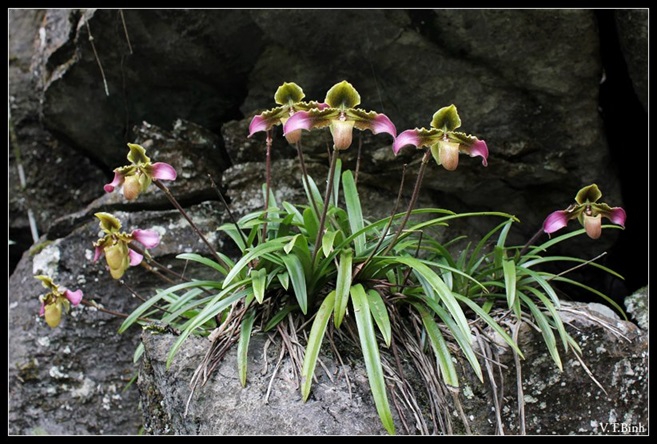
Image of hairy orchids growing on a rock outcrop.

A pot of Paphiopedilum orchids in full bloom.
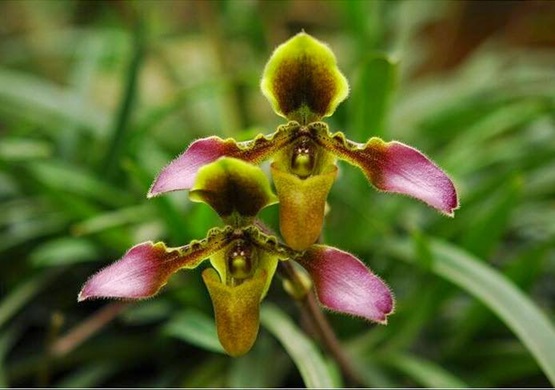
The orchids have unique shapes.
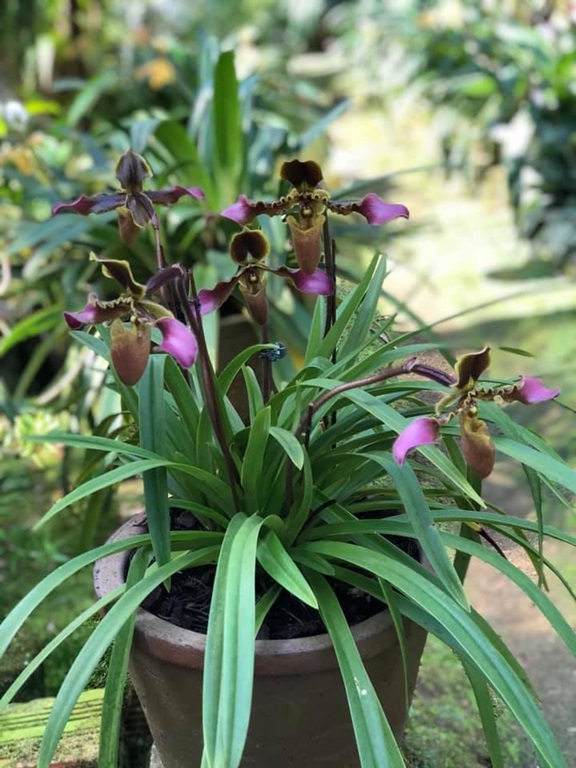
A beautiful blooming pot of orchid.
With its distinctive shape, unique flower structure, and mysterious quality, the Hairy Slipper orchid is truly worthy of being a rare orchid that professional orchid collectors must have. Although it requires strict care conditions as well as high techniques, in return you will get extremely worthy results with unique flowers that cannot be mistaken for any other.
Hopefully, the information that orchid-vn.com shares above will help you better understand this special wild orchid species. And don't forget to visit our Blog section to discover more beautiful orchid species.
